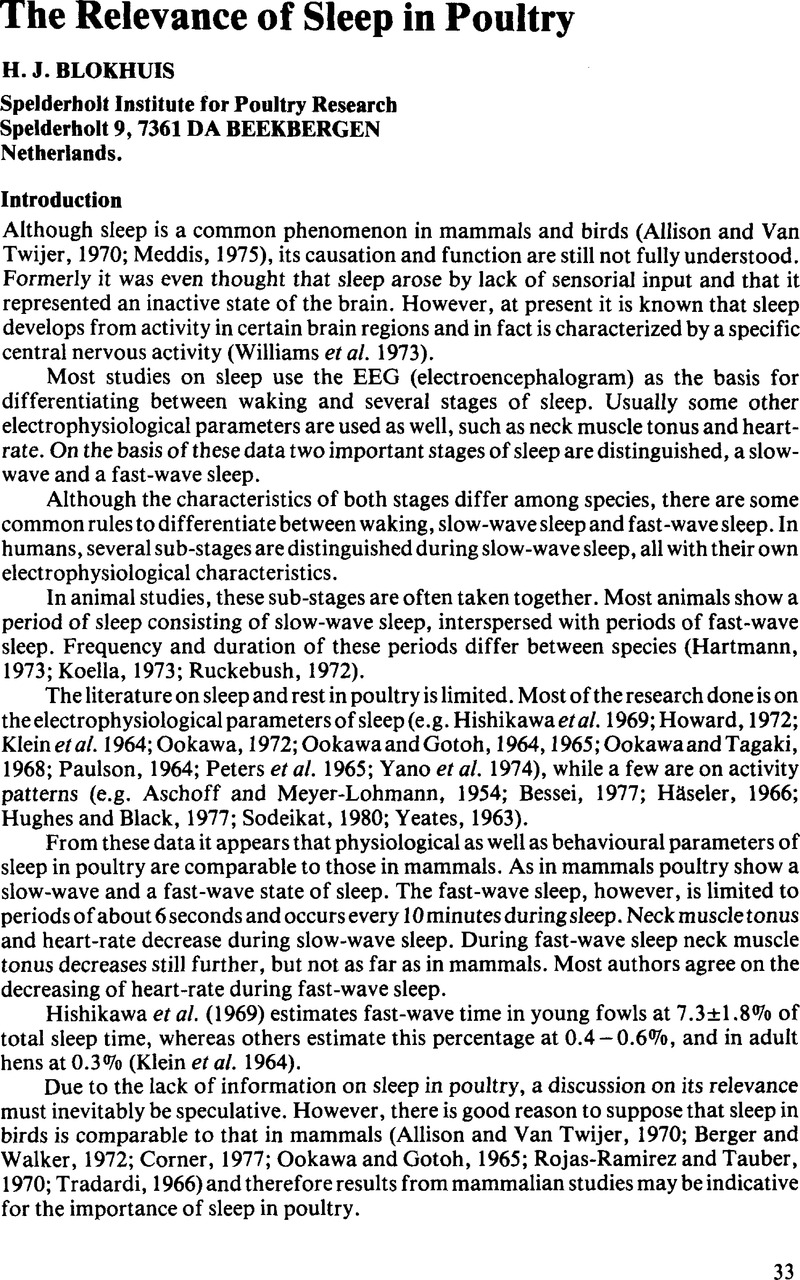Crossref Citations
This article has been cited by the following publications. This list is generated based on data provided by Crossref.
Blokhuis, H.J.
1984.
Rest in poultry.
Applied Animal Behaviour Science,
Vol. 12,
Issue. 3,
p.
289.
Rowland, K. W.
1985.
Intermittent Lighting for Laying Fowls: A Review.
World's Poultry Science Journal,
Vol. 41,
Issue. 1,
p.
5.
Lewis, P. D.
Perry, G. C.
and
Tuddenham, A.
1987.
Noise output of hens subjected to interrupted lighting regimens.
British Poultry Science,
Vol. 28,
Issue. 3,
p.
535.
Preston, A. P.
1987.
Restricted feeding time and the behaviour of caged laying hens.
British Poultry Science,
Vol. 28,
Issue. 3,
p.
387.
Murphy, Linda B.
and
Preston, A. P.
1988.
Time‐budgeting in meat chickens grown commercially.
British Poultry Science,
Vol. 29,
Issue. 3,
p.
571.
Lewis, P.D.
Perry, G.C.
Morris, T.R.
and
Midgley, M.M.
1992.
Intermittent lighting regimes and mortality rates in laying hens.
World's Poultry Science Journal,
Vol. 48,
Issue. 2,
p.
113.
Manser, C E
1996.
Effects of Lighting on the Welfare of Domestic Poultry: A Review.
Animal Welfare,
Vol. 5,
Issue. 4,
p.
341.
Duncan, I.J.
1998.
Behavior and behavioral needs.
Poultry Science,
Vol. 77,
Issue. 12,
p.
1766.
Weeks, C.A
Danbury, T.D
Davies, H.C
Hunt, P
and
Kestin, S.C
2000.
The behaviour of broiler chickens and its modification by lameness.
Applied Animal Behaviour Science,
Vol. 67,
Issue. 1-2,
p.
111.
Duncan, Ian J. H.
2001.
The pros and cons of cages.
World's Poultry Science Journal,
Vol. 57,
Issue. 4,
p.
381.
Sanotra, G. S.
Lund, J. D.
Ersøll, A. K.
Petersen, J. S.
and
Vestergaard, K. S.
2001.
Monitoring leg problems in broilers: a survey of commercial broiler production in Denmark.
World's Poultry Science Journal,
Vol. 57,
Issue. 1,
p.
55.
Campo, JL
and
Davila, SG
2002.
Effect of photoperiod on heterophil to lymphocyte ratio and tonic immobility duration of chickens.
Poultry Science,
Vol. 81,
Issue. 11,
p.
1637.
Odén, K.
Keeling, L.J.
and
Algers, B.
2002.
Behaviour of laying hens in two types of aviary systems on 25 commercial farms in Sweden.
British Poultry Science,
Vol. 43,
Issue. 2,
p.
169.
Saiful, Islam M.
Fujita, Masanori
and
Ito, Toshio
2002.
Effect of Physical Activities on Heat Production of White Leghorn Hens under Different Lighting Regimes..
The Journal of Poultry Science,
Vol. 39,
Issue. 3,
p.
159.
Sanotra, G.S.
Lund, J. Damkjer
and
Vestergaard, K.S.
2002.
Influence of light-dark schedules and stocking density on behaviour, risk of leg problems and occurrence of chronic fear in broilers.
British Poultry Science,
Vol. 43,
Issue. 3,
p.
344.
Riber, Anja B.
Nielsen, Birte L.
Ritz, Christian
and
Forkman, Björn
2007.
Diurnal activity cycles and synchrony in layer hen chicks (Gallus gallus domesticus).
Applied Animal Behaviour Science,
Vol. 108,
Issue. 3-4,
p.
276.
Campo, J.L.
Gil, M.G.
Dávila, S.G.
and
Muñoz, I.
2007.
Effect of Lighting Stress on Fluctuating Asymmetry, Heterophil-to-Lymphocyte Ratio, and Tonic Immobility Duration in Eleven Breeds of Chickens.
Poultry Science,
Vol. 86,
Issue. 1,
p.
37.
Branciari, R.
Mugnai, C.
Mammoli, R.
Miraglia, D.
Ranucci, D.
Dal Bosco, A.
and
Castellini, C.
2009.
Effect of genotype and rearing system on chicken behavior and muscle fiber characteristics1.
Journal of Animal Science,
Vol. 87,
Issue. 12,
p.
4109.
Alvino, G.M.
Blatchford, R.A.
Archer, G.S.
and
Mench, J.A.
2009.
Light intensity during rearing affects the behavioural synchrony and resting patterns of broiler chickens.
British Poultry Science,
Vol. 50,
Issue. 3,
p.
275.
Dal Bosco, A.
Mugnai, C.
Sirri, F.
Zamparini, C.
and
Castellini, C.
2010.
Assessment of a global positioning system to evaluate activities of organic chickens at pasture.
Journal of Applied Poultry Research,
Vol. 19,
Issue. 3,
p.
213.





